1996 CHEVROLET TAHOE check engine
[x] Cancel search: check enginePage 308 of 403
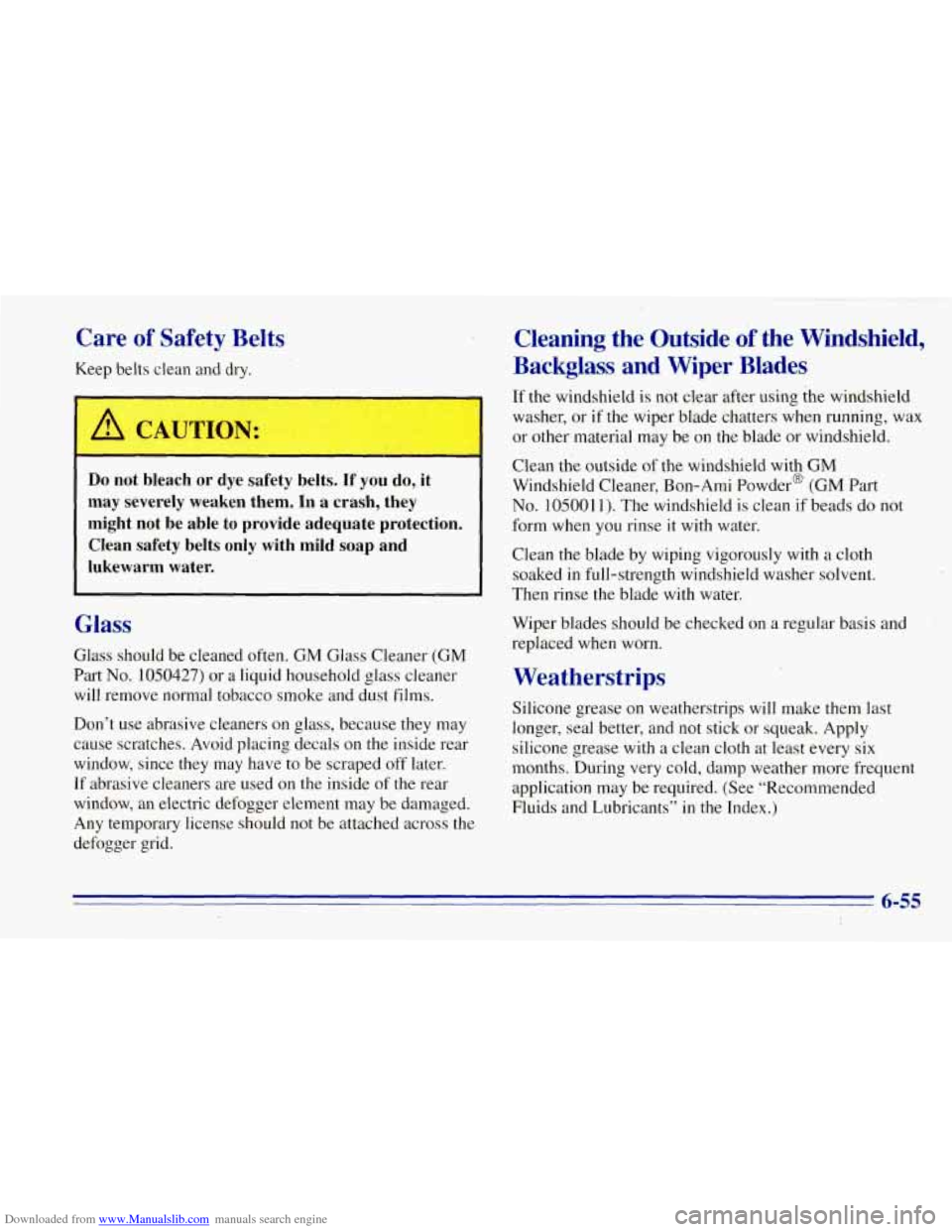
Downloaded from www.Manualslib.com manuals search engine Care of Safety Belts
Keep belts clean and dry.
A CAUTIOl.,
Do not bleach or dye safety belts. If you do, it
may severely weaken them.
In a crash, they
might not be able to provide adequate protection. Clean safety belts only with mild soap and
lukewarm water.
Glass
Glass should be cleaned often. GM Glass Cleaner (GM
Part No. 1050427) or a liquid household glass cleaner
will remove normal tobacco smoke and dust films.
Don’t use abrasive cleaners on glass, because they may
cause scratches. Avoid placing decals on the inside rear
window, since they may have to be scraped off later.
If abrasive cleaners are used on the inside of the rear
window, an electric defogger element may be damaged.
Any temporary license should not be attached across the
defogger grid.
Cleaning the Outside of the Windshield,
Batklass and Wiper Blades
If the windshield is not clear after using the windshield
washer, or if the wiper blade chatters when running, wax
or other material may be on the blade or windshield.
Clean the outside
of the windshield with GM
Windshield Cleaner, Bon-Ami Powder@’ (GM Part
No. 105001 1). The windshield is-clean if beads do not
form when
you rinse it with water.
Clean the blade by wiping vigorously with a cloth
soaked in full-strength windshield washer solvent.
Then rinse the blade with water.
Wiper blades .should be checked
on a regular basis and
replaced when worn.
Weatherstrips
Silicone grease on weatherstrips will make them last
longer, seal better, and not stick or squeak. Apply
silicone grease with a clean cloth at least every six
months. During very cold, damp weather more frequent
application may
be required. (See “Recommended
Fluids and Lubricants” in the Index,)
6-55
Page 314 of 403
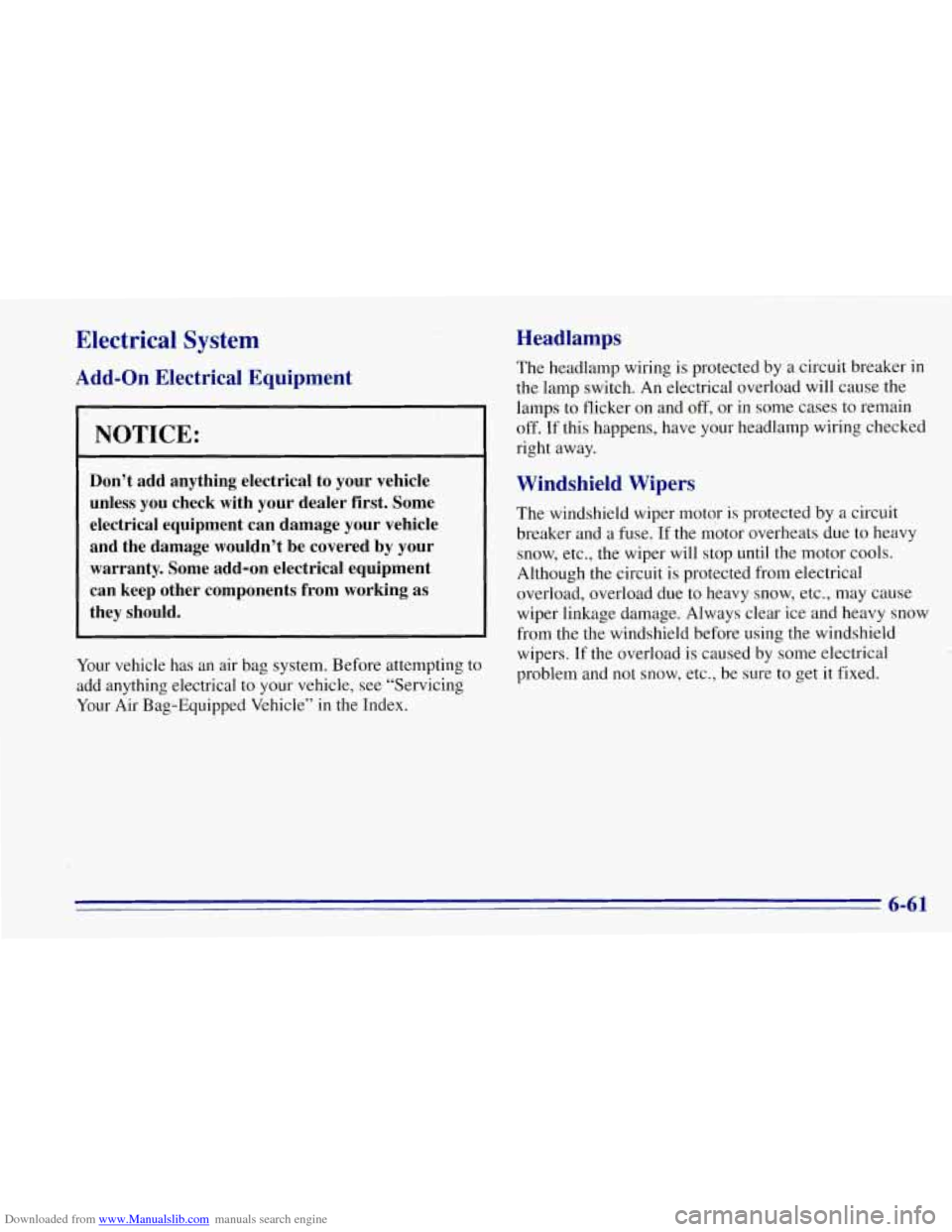
Downloaded from www.Manualslib.com manuals search engine Electrical System
Add-on Electrical Equipment
NOTICE:
Don’t add anyth’ing electrical to your vehicle
unless you check with your dealer first. Some
electrical equipment can damage your vehicle
and the damage wouldn’t be covered by your
warranty. Some add-on electrical equipment
can keep other components from working
as
they should.
Your vehicle has an air bag system. Before attempting to
add anything electrical to your vehicle, see “Servicing
Your Air Bag-Equipped Vehicle” in the Index.
Headlamps
The headlamp wiring is protected by a circuit breaker in
the lamp switch. An electrical overload will cause the
lamps
to flicker on and off, or in some cases to remain
off. If this happens, have your headlamp wiring checked
right away.
Windshield Wipers
The windshield wiper motor is protected by a circuit
breaker and a fuse. If the motor overheats due
to heavy
snow, etc,, the wiper will stop until the motor cools.
Although the’circuit is protected from electrical
overload, overload due to heavy snow, etc., may cause
wiper linkage damage. Always clear ice and heavy snow
from the
the windshield before using the windshield
wipers. If the overload is caused by some electrical
problem and not
snow, etc., be sure to get it fixed.
6-61
Page 318 of 403
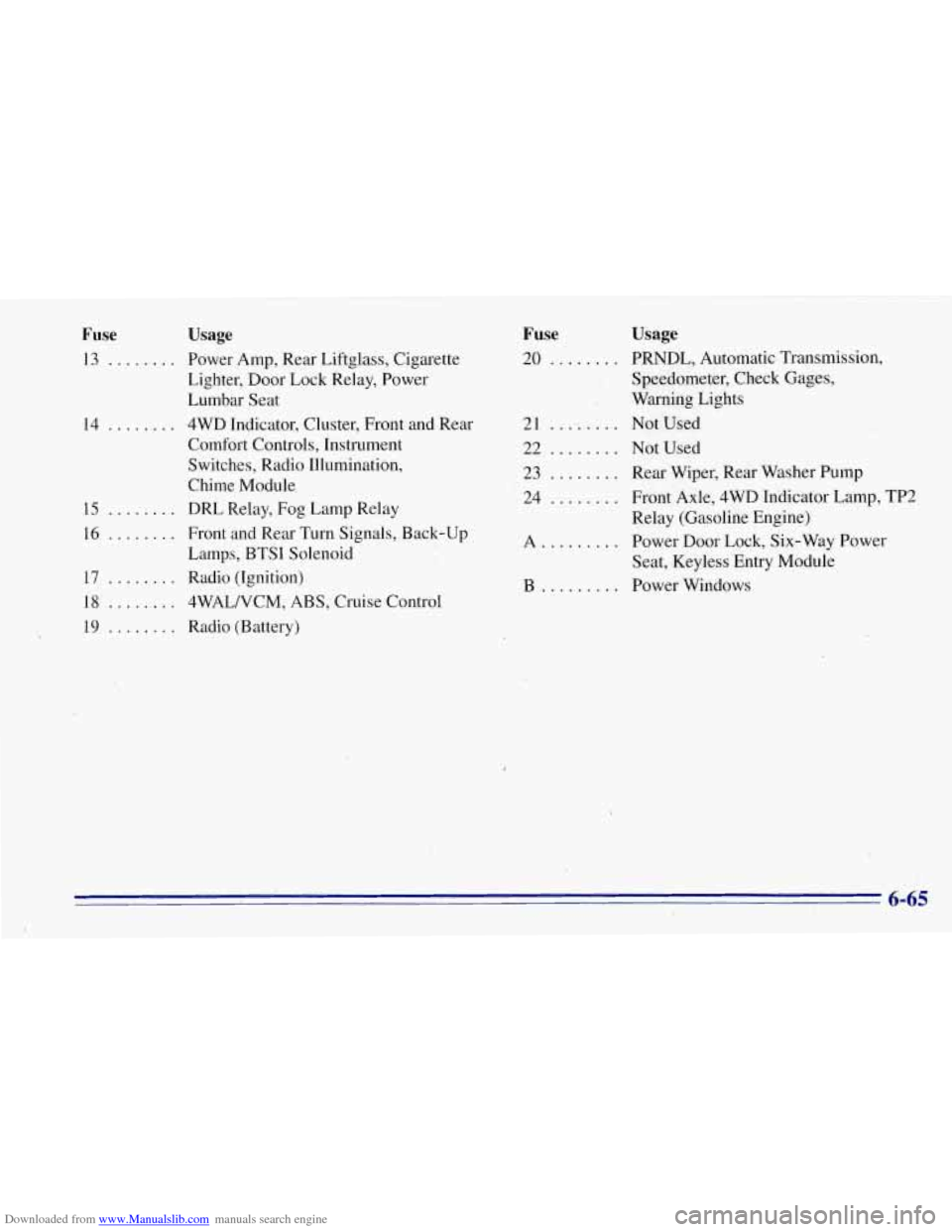
Downloaded from www.Manualslib.com manuals search engine Fuse Usage
13 ........ Power Amp, Rear Liftglass, Cigarette
Lighter, Door Lock Relay, Power
Lumbar Seat
Comfort Controls, instrument
Switches, Radio Illumination,
Chime Module
15
........ DRL Relay, Fog Lamp Relay
16
........ Front and Rear Turn Signals, Back-up
Lamps, BTSI Solenoid
17
........ Radio (Ignition)
18
........ 4WAL/VCM, ABS, Cruise Control
19
........ Radio (Battery)
14
........ 4WD Indicator, Cluster,
Front and Rear
Fuse Usage
20 ........ PRNDL, Automatic Transmission,
4. ,,/ J - ;c- ; Speedometer, Check Gages, .. '.. - *. 1'). 'I :,,:-: . .-.?Warning ,. Lights .- .
21 ........ Not Used
22
........ Not Used
23
........ Rear Wiper, Rear Washer Pump
24
........ Front Axle, 4WD Indicator Lamp, TP2
Relay (Gasoline Engine)
A ......... Power Door Lock, Six-Way Power
Seat, Keyless Entry Module
B ......... Power Windows
6-65
Page 325 of 403
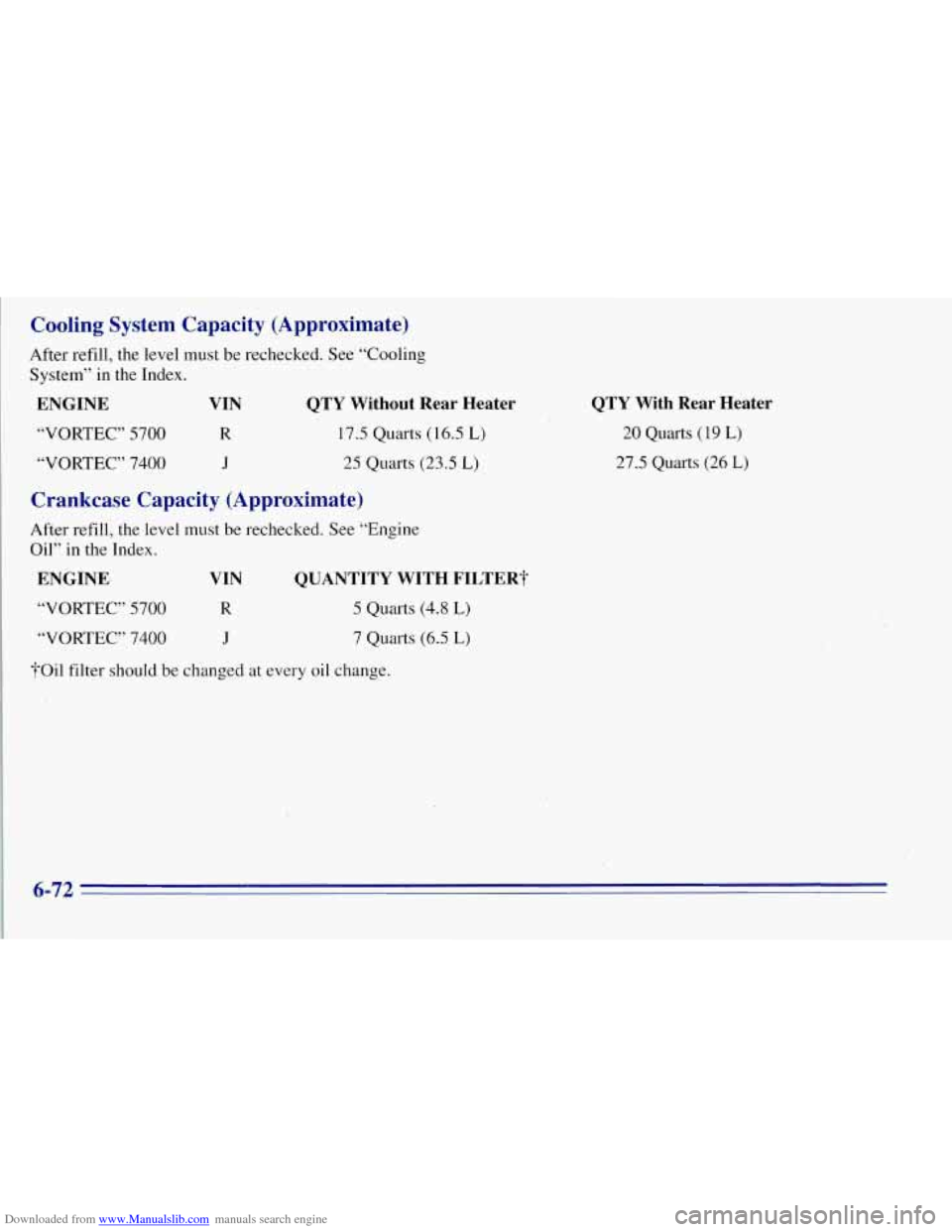
Downloaded from www.Manualslib.com manuals search engine Cooling System Capacity (Approximate)
After refill, the level must be rechecked. See “Cooling
System” in the Index.
ENGINE VIN QTY Without Rear Heater
“VORTEC” 5700
R 17.5 Quarts (1615 L)
“VORTEC” 7400 J 25 Quarts (23.5 L)
Crankcase Capacity (Approximate)
After refill, the level must be rechecked. See “Engine
Oil” in the Index.
ENGINE, VIN QUANTITY WITH FILTER?
“VORTEC” 5700 R 5 Quarts (4.8 L)
“VORTEC” 7400 J 7 Quarts (6.5 L)
?Oil filter should be changed at every oil change.
QTY With Rear Heater
20 Quarts (19 L)
27.5 Quarts (26 L)
6-72
Page 329 of 403

Downloaded from www.Manualslib.com manuals search engine How This Section is Organized
The remainder of this section is divided into five parts:
“Part A: Scheduled Maintenance Services” shows
what to h-ave done and how often. Some
of these
services can be complex,
so unless you are technically
qualified and have the necessary equipment,
you should
let your dealer’s service department or another qualified
service center
do these jobs.
A CAUTION:
I
If you are skilled enough to do some work on your
vehicle, you will probably want to get
the service
information
GM publishes. See “Service and Owner
Publications”
in the Index.
“Part B: Owner Checks and Services” tells you
what should be checked whenever you stop for fuel. It
also explains what you can easily do to help keep your
vehicle in good condition.
“Part C: Periodic Maintenance Inspections”
explains important inspections that your GM dealer’s
service department or another qualified service center
should perform.
Performing maintenance work on a vehicle can “Part D: Recommended Fluids and Lubricants”
be dangerous. In trying to do some jobs, you can
be seriously injured.
Do your own maintenance
work only
if you have the required know-how
’ and the proper tools and equipment for the job.
If.you have any doubt, have a qualified “Part
E: Maintenance Record” provides a place
technician do the work.
lists some products GM recommends to help keep your
vehicle properly maintained. These products, or their
equivalents, should be used whether you do the.work
yourself or have
it done.
for
you to record the maintenance performed on your
vehicle. Whenever any maintenance is performed, be
I I sure to write it down in this part. This will help you
determine when your next maintenance should be done.
In addition, it is a good idea to keep your maintenance
receipts. They may be needed to qualify your vehicle for
warranty repairs.
Page 330 of 403
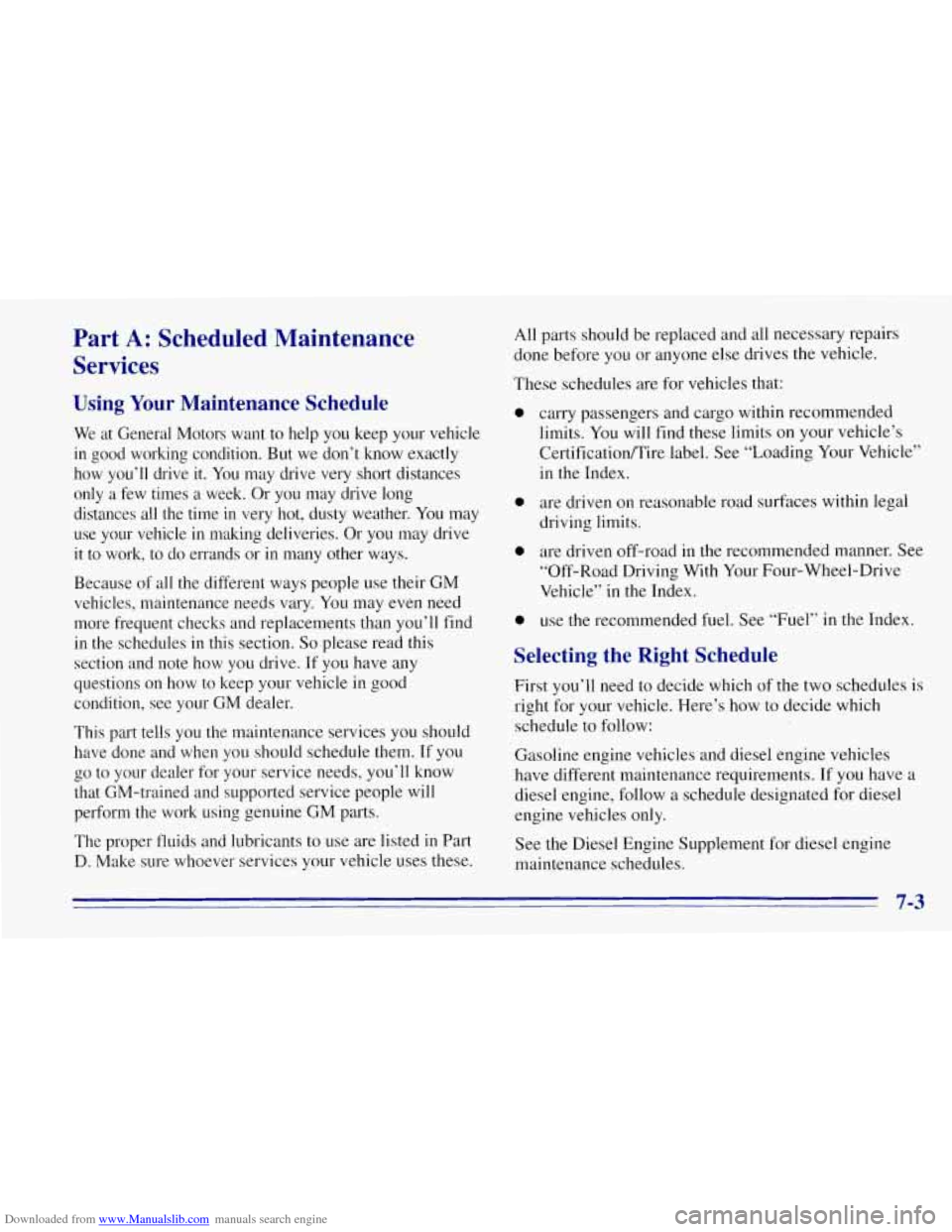
Downloaded from www.Manualslib.com manuals search engine Part A:’ Scheduled-Maintenance
Services
Using Your Maintenance Schedule
We at General Motors want to help you keep your vehicle
in good working condition. But we don’t know exactly
how you’ll drive it. You may drive very
short distances
only a few times a week. Or you may drive long
distances all the time in very hot, dusty weather. You may
use your vehicle in making deliveries. Or you may drive
it to work, to do en-ands or in many other ways.
Because
of all the different ways people use their GM
vehicles, maintenance needs vary.
You may even need
more frequent checks and replacements than you’ll find
in the schedules
in this section. So please read this
section and note how you drive.
If you have any
questions on how to keep your vehicle in good
condition, see your GM dealer.
This part tells you the maintenance services you should
have done and when
you should schedule them. If you
go to your dealer for your service needs, you’ll know
that GM-trained and supported service people will
perform the work using genuine GM parts.
The proper fluids and lubricants to use are listed in Part
D. Make sure whoever services your vehicle uses these. All
parts should be replaced and all necessary repairs
done before you or anyone else drives the vehicle.
These schedules are for vehicles that:
0
0
0
0
carry passengers and cargo within recommended
limits. You will find these limits
on your vehicle’s
CertificatiodTire label. See “Loading Your Vehicle”
in the Index.
are driven on reasonable road surfaces within legal
driving limits.
are driven off-road in the recommended manner. See
“Off-Road Driving With Your Four-Wheel-Drive
Vehicle” in the Index.
use the recommended fuel. See “Fuel” in the Index.
Selecting the Right Schedule
First you’ll need to decide which of the two schedules is
right for your vehicle. Here’s how to decide which
schedule to follow:
Gasoline engine vehicles and diesel engine vehicles
have different maintenance requirements.
If you have a
diesel engine, follow a schedule designated for diesel
engine vehicles only.
See the Diesel Engine Supplement for diesel engine
maintenance schedules.
7-3
Page 331 of 403
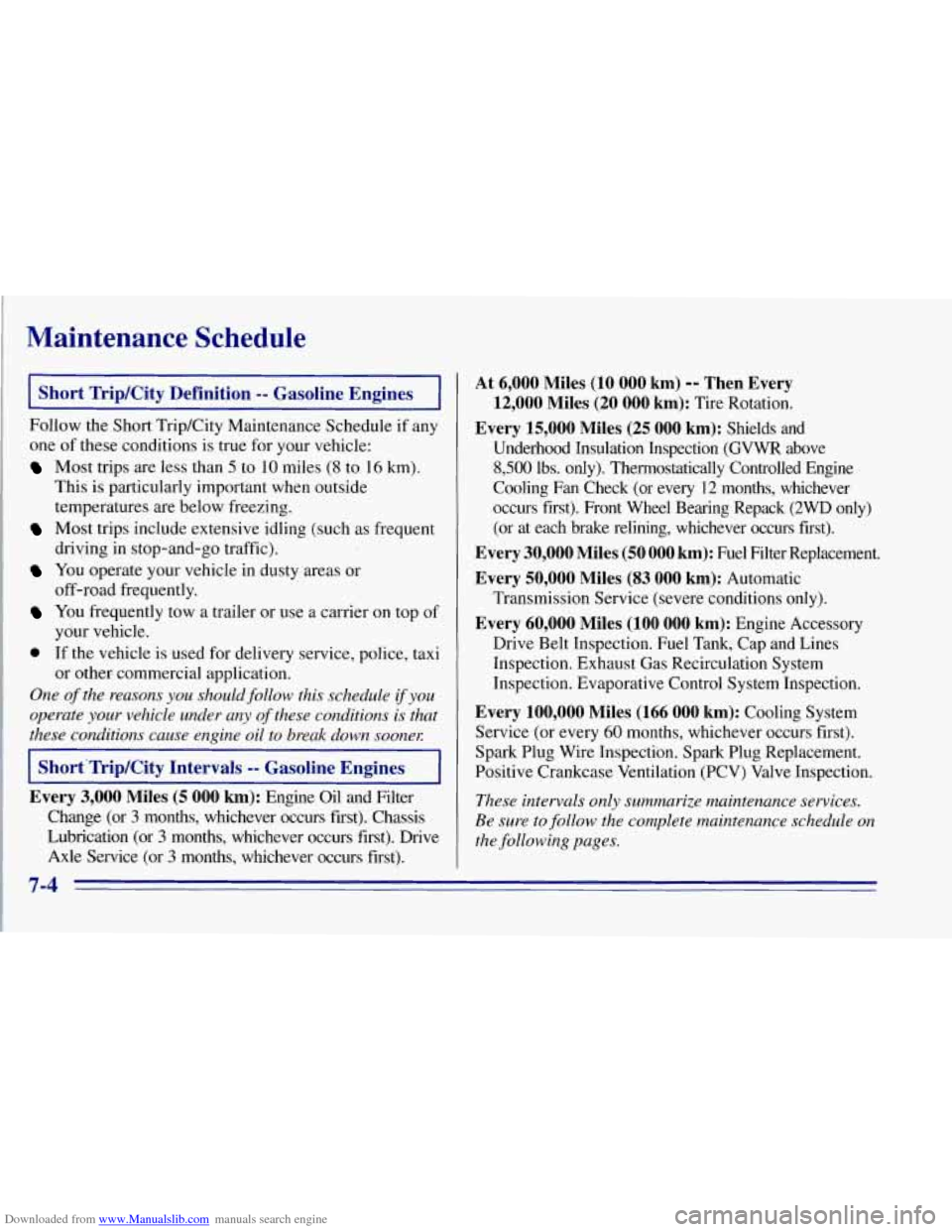
Downloaded from www.Manualslib.com manuals search engine Maintenance Schedule
Short Trip/City Definition -- Gasoline Engines
Follow the Short TripKity Maintenance Schedule if any
one of these conditions is true
for your vehicle:
Most trips are less than 5 to 10 miles (8 to 16 km).
This is particularly important when outside
temperatures are below freezing.
driying in stop-and-go traffic).
off-road frequently.
your vehicle.
or other, commercial application.
Most trips include extensive idling (such as frequent
You operate your vehicle in dusty areas or
You frequently tow a trailer or use a carrier on top of
0 If the vehicle is used for delivery service, police, taxi
One of the reasons you should follow this schedule if you
operate your vehicle under any
of these conditions is that
these conditions cause engine oil to break down soonel:
Short'Trip/City Intervals -- Gasoline Engines
Every
3,000 Miles (5 000 km): Engine Oil and Filter
Change (or
3 months, whichever occurs first). Chassis
Lubrication (or
3 months, whichever occurs first). Drive
Axle Service (or
3 months, whichever occurs first).
At 6,000 Miles (10 000 km) -- Then Every
12,000 Miles (20 000 km): Tire Rotation.
Every 15,000 Miles (25 000 km): Shields and
Underhood Insulation Inspection (GVWR above
8,500 lbs. only). Thermostatically Controlled Engine
Cooling
Fan Check' (or every 12 months, whichever
occurs first). Front Wheel Bearing Repack
(2WD only)
(or at each brake relining, whichever occurs first).
Every 30,000 Miles (50 000 km): Fuel Filter Replacement.
Every 50,000 Miles (83 000 km): Automatic
Transmission Service (severe conditions only).
Every 60,000 Miles (100 000 km): Engine Accessory
Drive Belt Inspection. Fuel Tank, Cap and Lines
Inspection. Exhaust Gas Recirculation System
Inspection. Evaporative Control System Inspection.
Every 100,000 Miles (166 000 km): Cooling System
Service (or every
60 months, whichever occurs first).
Spark Plug Wire Inspection. Spark Plug Replacement.
Positive Crankcase Ventilation (PCV) Valve Inspection.
These intervals only summarize maintenance services.
Be sure to follow the complete maintenance schedule
on
the following pages.
Page 332 of 403
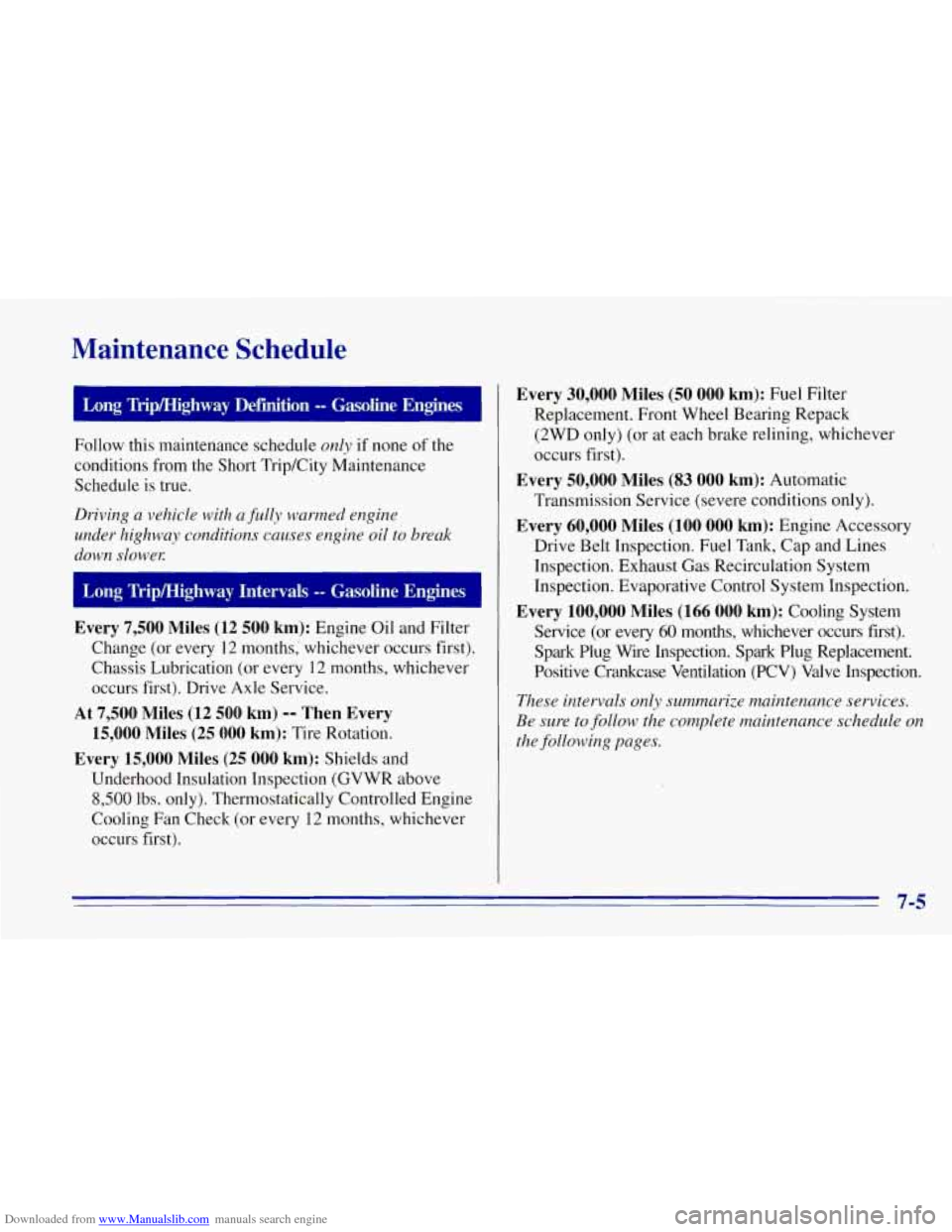
Downloaded from www.Manualslib.com manuals search engine Maintenance Schedule
Follow this maintenance schedule only if none of the
conditions from the Short Trip/City Maintenance
Schedule is true.
Driving a vehicle with a fully warmed engine
under highway conditions causes engine oil to break
down
s10w.e~
Every 7,500 Miles (12 500 km): Engine Oil and Filter
Change (or every
12 months,' whichever occurs first).
Chassis Lubrication (or every 12 months, whicheve
occurs first). Drive Axle Service.
At 7,500 Miles (12 500 km) -- Then Every
15,000 Miles (25
000 km): Tire Rotation.
Every 15,000 Miles (25 000 km): Shields and
Underhood Insulation Inspection (GVWR above :r
8,500 lbs. only). Thermostatically Controlled
Engine
Cooling Fan Check (or every 12 months, whichever
occurs first).
Every 30,000 Miles (50 000 km): Fuel Filter
Replacement. Front Wheel Bearing Repack (2WD only) (or at each brake relining, whichever
occurs first).
Every 50,000 Miles (83 000 km): Automatic
Transmission Service (severe conditions only).
Every 60,000 Miles (100 000 km): Engine Accessory
Drive Belt Inspection. Fuel Tank, Cap and Lines
Inspection. Exhaust Gas Recirculation System
Inspection. Evaporative Control ,System Inspection.
Every 100,000 Miles (166 000 km): Cooling System
Service
(or every 60 months, whichever occurs first).
Spark Plug Wire Inspection.
Spark Plug Replacement.
Positive Crankcase Ventilation (PCV) Valve Inspection.
These intervals only summarize maintenance services.
Be sure to
follow the complete maintenance schedule on
the following pages.
7-5